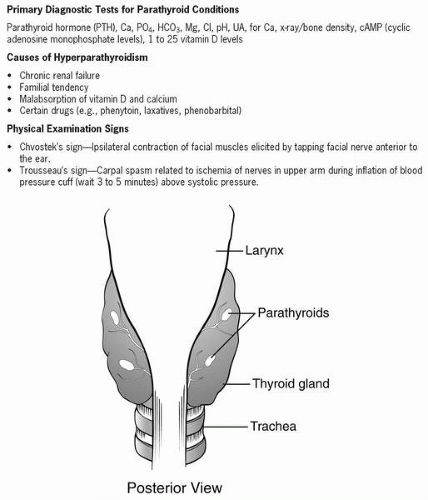The Parathyroid Gland
The parathyroid glands are comprised of four glands in the posterior aspect of the thyroid gland. These four glands are responsible for the production of parathyroid hormone, which regulates calcium and phosphorus levels in the body. Elevated levels of parathyroid hormone can have potentially life-threatening consequences if there is no intervention.
The parathyroid glands are located behind the upper and lower poles of the thyroid, which is anterior to the larynx. There are commonly four parathyroid glands, although there can be as few as two or as many as six. The parathyroid glands produce parathyroid hormone (PTH), which maintains calcium homeostasis. PTH is primarily regulated by the serum level of ionized calcium. If serum calcium is low, PTH is released. If it is high, PTH is suppressed. PTH is not part of the hypothalamic-pituitary feedback mechanism, so marked increases or decreases can have severe consequences. Magnesium and phosphate levels also influence PTH secretion in that hyperphosphatemia leads to hypocalcemia, which in turn influences PTH secretion. The relationship among these three minerals is complex. Calcitonin, produced by the thyroid, also plays a role in controlling serum calcium levels by increasing bone formation by osteoblasts and decreasing bone breakdown by osteoclasts. Its effect is to decrease serum calcium levels and conserve bone matrix.
PTH is the most important hormone in the regulation of serum calcium levels. It is secreted in response to lowered serum calcium levels and acts directly on bone (the body’s primary reservoir of calcium) by causing release of calcium from the bone and on the kidneys. PTH causes bone resorption or breakdown of osteoclasts, thereby increasing serum calcium levels. If PTH release is chronically stimulated, it results in bone remodeling. PTH also acts in the proximal and distal tubules of the kidneys to increase reabsorption of calcium and decrease reabsorption of phosphorus, thereby increasing serum levels of calcium and phosphate. In addition, it influences tubular reabsorption of bicarbonate and stimulates the synthesis of biologically active vitamin D. Vitamin D facilitates calcium and phosphorus transport through the intestinal wall. Elevated levels of serum magnesium inhibit the secretion of PTH.
Stay updated, free articles. Join our Telegram channel

Full access? Get Clinical Tree




